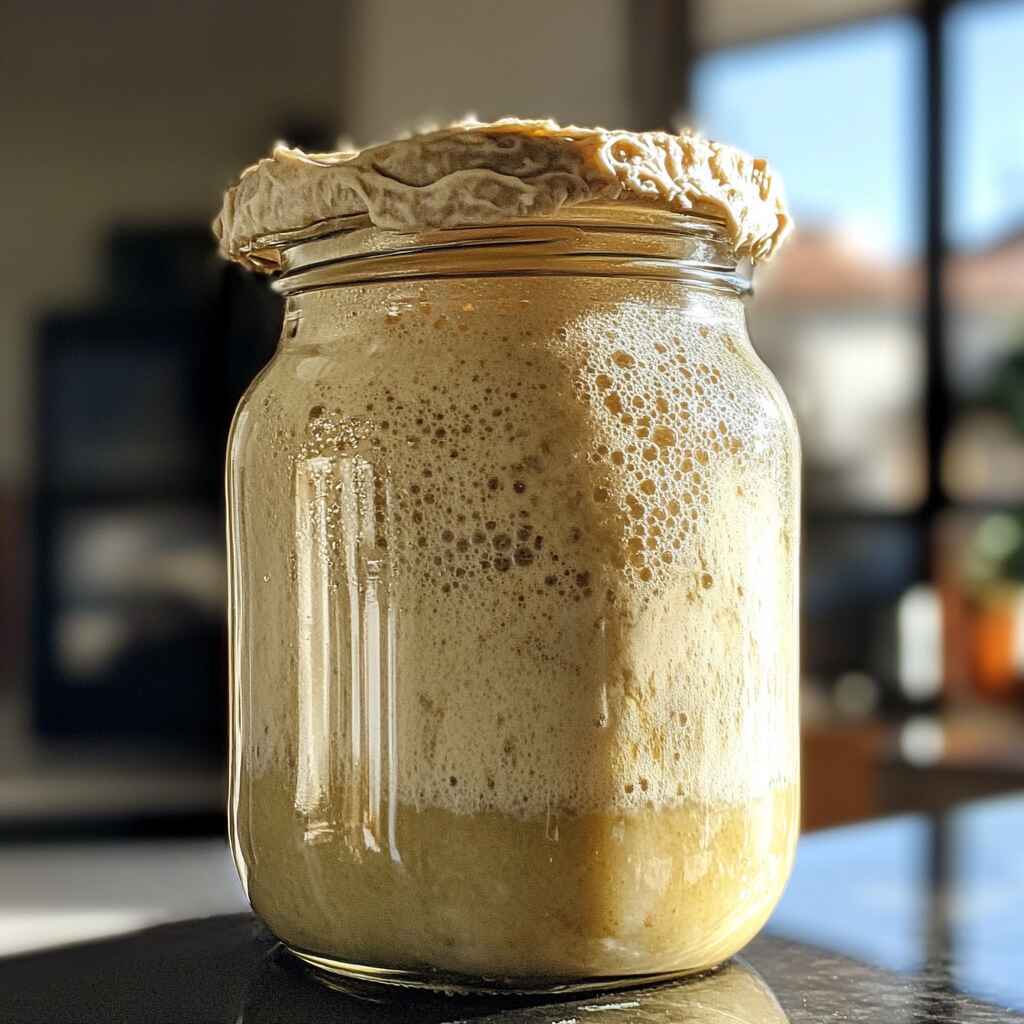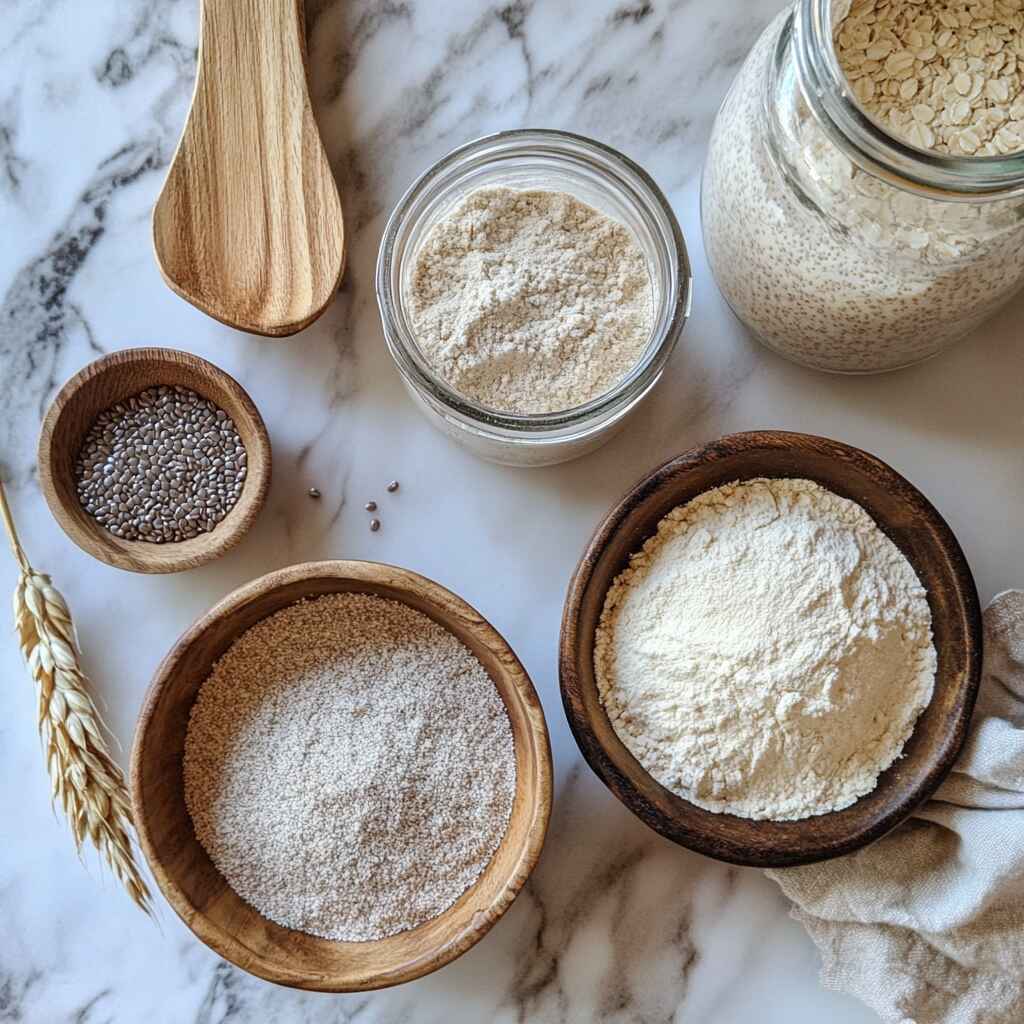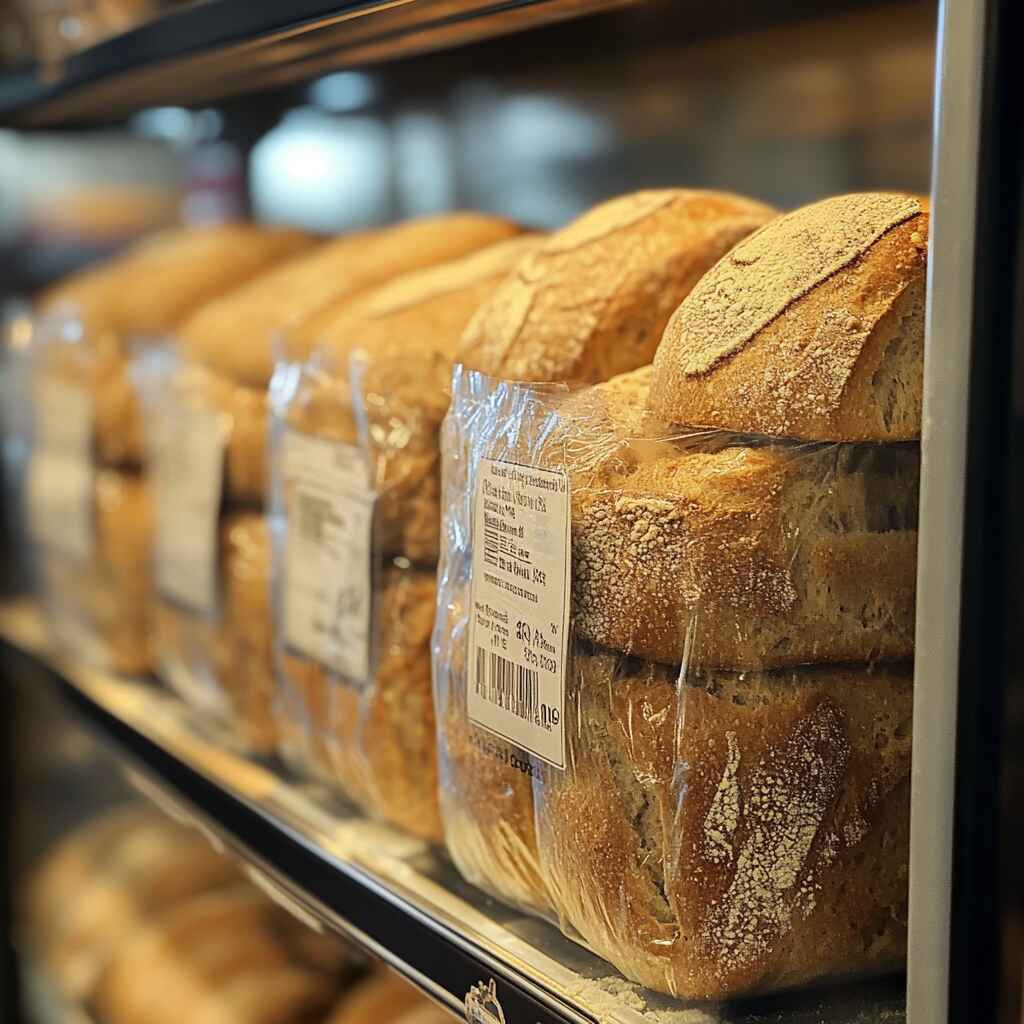If you’re someone who’s gluten-intolerant, health-conscious, or just curious about gut-friendly baking, then gluten free sourdough bread is about to become your new obsession. Unlike typical gluten-free loaves that are dense or flavorless, gluten free sourdough bread delivers a naturally fermented, airy crumb with a rich tang that your taste buds—and your gut—will love.
This complete guide will show you everything you need to know about baking gluten free sourdough bread from scratch. We’ll cover how it’s made, which flours perform best, how to troubleshoot common issues, and whether gluten-free sourdough really is anti-inflammatory. You’ll also discover where to buy quality loaves and how to choose the healthiest ones.
Learn more about protein baked oats that are perfect for gluten-free diets and expand your healthy baking skills today.
Understanding Gluten-Free Sourdough Bread
What is Gluten-Free Sourdough Bread?
Gluten free sourdough bread is a naturally fermented bread made without gluten-containing grains like wheat, rye, or barley. Traditional sourdough relies on wild yeast and beneficial bacteria to ferment gluten-rich dough, but gluten free sourdough bread uses alternative flours like brown rice, sorghum, or buckwheat. Despite being gluten-free, it still produces a rich, tangy flavor and soft interior thanks to the fermentation process.
What makes gluten free sourdough bread so appealing is that it doesn’t rely on synthetic additives or gums to rise or develop structure. Instead, it’s built around a naturally fermented starter made from gluten-free flours and water. This makes it a perfect bread for people with celiac disease, non-celiac gluten sensitivity, or anyone simply seeking a healthier alternative.
For many, gluten free sourdough bread offers a return to real bread—something flavorful, nourishing, and satisfying without compromising dietary needs.
How It Differs from Traditional Sourdough
The biggest difference between gluten free sourdough bread and regular sourdough lies in the behavior of the flour. Gluten acts as a natural binder and structural net in traditional dough, giving it its elastic rise. Since gluten-free flours lack this component, ingredients like psyllium husk, chia seeds, or flaxseed are used to help the dough hold together and trap fermentation gases.
Fermentation timing can also differ. Gluten free sourdough starters typically need a few extra days to become fully active. Hydration levels are higher too—gluten-free doughs tend to be wetter and stickier, which can be surprising to bakers used to working with wheat flour.
Still, when balanced correctly, gluten free sourdough bread delivers all the character of traditional loaves: crisp crusts, chewy texture, and that unmistakable tang—all without the gluten.
Looking for inspiration? Try our cloud bread breakfast sandwich recipe for another gluten-free breakfast idea.
The Science Behind Sourdough Fermentation
Natural Fermentation & Its Role
At the heart of every true sourdough—gluten-free or not—is a living culture called a starter. This mixture of flour and water is teeming with wild yeast and lactic acid bacteria, which feed on sugars and produce carbon dioxide and acids. The carbon dioxide makes the dough rise, while the acids give sourdough its signature tang and improve shelf life.
In gluten free sourdough bread, the fermentation process is just as crucial, if not more so. Since gluten-free flours lack the structural network gluten provides, fermentation becomes key to both flavor and texture. A well-fed gluten-free starter can create light, airy loaves that are full of character—something rarely achieved with commercial gluten-free bread mixes.
The starter also breaks down complex carbohydrates and antinutrients like phytic acid, making nutrients in the bread more bioavailable. That’s a big win for gut health and nutrient absorption.
This slow, natural fermentation is what sets sourdough apart from conventional bread—giving gluten free sourdough bread both artisanal flair and functional benefits.
Why Sourdough May Be Easier to Digest
Ever wonder why some people with gluten sensitivity can tolerate sourdough better than standard bread? It comes down to the way fermentation affects the grain’s structure.
During fermentation, the wild microbes partially break down gluten, FODMAPs, and starches. While this doesn’t make wheat-based sourdough safe for those with celiac disease, it may reduce symptoms for those with non-celiac gluten sensitivity.
In the case of gluten free sourdough bread, you’re getting the best of both worlds—bread made without gluten and improved digestibility thanks to fermentation. This process can lower the glycemic index of the bread, reduce bloating, and support the growth of beneficial gut bacteria.
Fermented bread also tends to have a longer shelf life without needing preservatives, making gluten free sourdough bread a wholesome option for clean-eating enthusiasts.
Discover great ideas like our keto chicken casserole—perfect if you’re looking to pair low-carb meals with your sourdough.
Is Gluten-Free Sourdough Bread Possible?

How It’s Made Without Gluten
You might be asking, “Is gluten-free sourdough bread really a thing?” The short answer: yes, absolutely—and it’s not just possible, it’s delicious.
Traditional sourdough relies on wheat-based flour to develop structure through gluten. But in gluten free sourdough bread, that structure comes from alternative flours paired with natural binders like psyllium husk, ground chia seeds, or flaxseed meal. These ingredients mimic gluten’s elasticity, helping the dough rise and hold its shape during baking.
It all starts with a gluten-free sourdough starter, which can be made with brown rice flour, sorghum, or millet. This living culture ferments over several days, just like its gluten-based counterpart. Once bubbly and active, it’s ready to be used in bread recipes.
The fermentation process creates flavor complexity and enhances digestibility, even without wheat. By allowing the starter to grow and mature, you end up with a loaf of gluten free sourdough bread that tastes artisanal, feels nourishing, and satisfies like traditional bread.
The Truth About “Naturally Gluten-Free” Sourdough
There’s a common misconception floating around that all sourdough is low in gluten, or even gluten-free, due to fermentation. While it’s true that fermentation reduces gluten content, it does not eliminate it. Traditional sourdough bread made with wheat is not safe for those with celiac disease or gluten intolerance.
That’s where true gluten-free sourdough bread comes in—it’s made with zero gluten from the beginning. There are no traces of wheat, rye, or barley, and when prepared correctly, it’s fully safe for gluten-free diets.
If you’re buying sourdough at a bakery or grocery store, don’t assume it’s gluten-free unless the label says so. Look for certified gluten-free options, or better yet, make your own at home where you can control every ingredient.
Don’t miss our guide to no-bake chocolate oat bars for another gut-friendly, gluten-free treat.
Print
Gluten-Free Sourdough Bread
- Total Time: 6 hours
- Yield: 1 medium loaf (8–10 slices)
- Diet: Gluten Free
Description
This homemade gluten-free sourdough bread is light, flavorful, and perfect for those with gluten intolerance or celiac disease. Naturally fermented and free from commercial yeast, this loaf has a crispy crust, soft crumb, and tangy finish—just like traditional sourdough. Made using wholesome gluten-free flours, it’s ideal for toasting, sandwiches, or simply enjoyed fresh out of the oven.
Ingredients
1 cup active gluten-free sourdough starter (brown rice or sorghum-based)
1½ cups brown rice flour
¼ cup sorghum flour
2 tablespoons tapioca starch
1 tablespoon psyllium husk powder
1 tablespoon ground flaxseed
1½ cups warm filtered water
1 tablespoon extra virgin olive oil
1 teaspoon sea salt
Instructions
Prepare the starter: Feed your gluten-free sourdough starter 4–6 hours before baking. It should be bubbly and doubled in size.
Mix dry ingredients: In a large mixing bowl, combine the brown rice flour, sorghum flour, tapioca starch, psyllium husk, ground flaxseed, and sea salt.
Combine wet ingredients: In a separate bowl, mix your active starter with warm water and olive oil.
Make the dough: Pour the wet ingredients into the dry and stir until a sticky, thick dough forms. Let it sit for 5–10 minutes to allow the psyllium to absorb moisture.
First rise (bulk fermentation): Cover the bowl with a damp towel and let it rest in a warm place for 4–6 hours. It should rise slightly and show bubbles on the surface.
Shape the dough: Using oiled hands, shape the dough into a round or oval loaf. Place it on parchment paper inside a proofing basket or bowl.
Second rise (proofing): Let the shaped dough rise for another 1–2 hours at room temperature while your oven preheats to 450°F (232°C).
Score and bake: Transfer the dough (with parchment) into a preheated Dutch oven. Score the top with a sharp knife or bread lame. Cover and bake for 30 minutes. Uncover and bake an additional 15–20 minutes until golden brown.
Cool completely: Let the bread cool on a wire rack for at least 2 hours before slicing. This allows the crumb to set properly.
Notes
Use a kitchen scale for accurate flour measurements.
Always ensure your starter is gluten-free and free from contamination.
For a stronger sour flavor, extend the bulk fermentation by 2 hours.
You can substitute millet flour or teff for sorghum for a deeper flavor.
Store the loaf in a paper bag for up to 2 days, or slice and freeze for longer shelf life.
- Prep Time: 20 minutes
- Cook Time: 45 minutes
- Category: Bread
- Method: Baking
- Cuisine: International
Best Gluten-Free Flours for Sourdough Baking
Top Gluten-Free Flour Choices (Rice, Sorghum, Teff, etc.)
When it comes to crafting quality gluten free sourdough bread, the flour you choose makes all the difference. Not all gluten-free flours behave the same—some are great for structure, others for flavor, and a few offer amazing nutritional boosts. Using a smart combination of them helps create the perfect loaf.
Here are the top gluten-free flours for sourdough:
| Flour Type | Texture & Flavor | Nutritional Benefit |
|---|---|---|
| Brown Rice Flour | Mild, neutral, slightly gritty | High in manganese and selenium |
| Sorghum Flour | Soft, wheat-like flavor | Rich in fiber and antioxidants |
| Teff Flour | Earthy, nutty taste | High in protein, iron, and calcium |
| Buckwheat Flour | Strong, nutty flavor | Full of magnesium and prebiotics |
| Millet Flour | Mild, fluffy texture | High in B-vitamins and phosphorus |
| Quinoa Flour | Slightly bitter, earthy | Contains complete protein and iron |
| Oat Flour* | Mild, slightly sweet | Heart-healthy fiber and beta-glucans |
*Ensure oats are certified gluten-free to avoid cross-contamination.
Each flour has its own personality. For a well-rounded loaf, many bakers use a blend—like brown rice for the base, sorghum for structure, and teff or buckwheat for flavor depth. Combining 2 to 4 flours is often the secret to artisan-quality gluten free sourdough bread.
Pros and Cons of Each Flour Type
Let’s dive deeper into the strengths and challenges of these flours when used in gluten-free sourdough baking:
Brown Rice Flour
- Pros: Affordable, readily available, neutral taste
- Cons: Can create a slightly gritty crumb if not blended
Sorghum Flour
- Pros: Mild flavor, mimics wheat flour texture
- Cons: Low binding power on its own
Teff Flour
- Pros: Boosts nutrition, great for dense loaves
- Cons: Can be expensive and heavier than others
Millet Flour
- Pros: Light texture, good moisture retention
- Cons: Tends to spoil quickly if not stored properly
Buckwheat Flour
- Pros: Rich flavor, helps structure
- Cons: Can overpower the loaf if used too much
Oat Flour
- Pros: Sweet flavor, adds softness
- Cons: Not suitable for celiacs unless certified gluten-free
When choosing flours, think balance—flavor, nutrition, texture, and fermentation compatibility. The right combo will give you a well-structured and flavorful gluten free sourdough bread that holds together and tastes amazing.
Check out our lesser-known favorite: eggs and cottage cheese protein meals—a powerhouse side dish for your sourdough slices.
How to Make Gluten-Free Sourdough Bread at Home

Ingredients and Tools Needed
Baking your own gluten free sourdough bread at home may seem intimidating, but with the right ingredients and tools, it’s absolutely doable—and incredibly rewarding. Unlike commercial gluten-free bread, this homemade version has depth, texture, and soul.
Basic Ingredients for the Bread:
- 1½ cups brown rice flour (or a blend of GF flours)
- 1 cup active gluten-free sourdough starter
- ¼ cup sorghum flour or teff flour (for richness)
- 1 tablespoon psyllium husk (binder)
- 1 tablespoon flaxseed meal (optional binder)
- 1½ cups filtered water (lukewarm)
- 1 teaspoon sea salt
- 1 tablespoon olive oil or avocado oil (moisture)
Tools You’ll Need:
- Glass or ceramic mixing bowl
- Silicone spatula
- Digital kitchen scale
- Dutch oven or bread pan
- Parchment paper
- Kitchen towel or proofing cloth
- Bread lame or sharp knife for scoring
These basics will help you create a reliable dough. As you get comfortable, you can start experimenting with flour blends and hydration levels for different textures and flavor profiles.
Step-by-Step Recipe Walkthrough
Follow this process for a no-fail loaf of homemade gluten free sourdough bread:
- Feed Your Starter (Day Before):
Make sure your gluten-free sourdough starter is active. Feed it with equal parts flour and water and let it sit for 4–8 hours until bubbly. - Mix the Dough (Day Of):
In a large bowl, combine your gluten-free flours, psyllium husk, salt, and flax meal. Add the starter, water, and oil. Mix until a sticky dough forms. Don’t knead—just stir well until fully hydrated. - Bulk Ferment (4–6 Hours):
Cover the bowl with a towel and let the dough rise in a warm area (70–75°F). It may not double in size like wheat dough, but you should see some puffiness and bubbles. - Shape the Dough:
Lightly oil your hands and gently shape the dough into a round or oblong loaf. Place it on parchment inside a proofing bowl or directly in your baking vessel. - Final Proof (1–2 Hours):
Let the dough rise again, covered, while you preheat the oven to 450°F (232°C). Place a Dutch oven inside during preheat if using. - Score and Bake:
Use a lame or sharp knife to score the loaf—this controls the expansion. Place it in the hot oven (or Dutch oven), cover, and bake for 30 minutes. Remove the lid and bake an additional 15–25 minutes until golden brown and crisp. - Cool Before Slicing:
Let your gluten free sourdough bread cool completely on a wire rack before slicing. This is crucial—the crumb finishes setting as it cools.
The result? A crusty, golden artisan-style loaf with that classic sourdough tang, a chewy crumb, and zero gluten.
Don’t miss our orphan link pick: blue salt trick recipe, a flavorful touch you can sprinkle on your next sourdough slice.
Troubleshooting Common Problems
Why Your Dough Isn’t Rising
One of the biggest concerns for home bakers attempting gluten free sourdough bread is a loaf that doesn’t rise. Unlike wheat-based doughs, gluten-free versions need extra attention when it comes to fermentation, hydration, and structure.
Here are common causes and simple fixes:
- Inactive Starter: Your gluten-free sourdough starter may not be mature enough. A strong starter should double in size 4–6 hours after feeding and produce bubbles with a mild sour aroma. Fix: Continue feeding the starter daily with equal parts gluten-free flour and water for another 2–3 days before baking.
- Wrong Flour Blend: Using only one type of flour can cause poor fermentation or flat dough. Some flours lack the fermentable sugars yeast feeds on. Fix: Use a blend of brown rice, sorghum, and teff for better balance and rise.
- Insufficient Fermentation Time: Unlike wheat doughs, gluten-free sourdough may take longer to rise due to denser ingredients. Fix: Extend bulk fermentation by 1–2 hours and ensure your kitchen is warm enough (70–75°F).
- Too Much Water: While hydration is important, overhydrating gluten-free dough leads to collapse and gummy texture. Fix: Adjust water ratio slightly down and incorporate psyllium husk to absorb excess moisture.
How to Improve Texture and Taste
Getting the right crumb texture and that authentic sour tang can be a challenge. But once you dial in a few techniques, your gluten free sourdough bread will rival bakery-style loaves.
Improving Texture
- Add psyllium husk or chia seeds to mimic gluten structure and create stretchiness in the dough.
- Let the loaf cool completely after baking before slicing. Warm gluten-free bread may seem gummy if cut too soon.
- Bake with steam (by adding a pan of hot water to the oven) or use a Dutch oven for better oven spring and crust.
Boosting Flavor
- Extend fermentation slightly for a tangier, more pronounced sour flavor.
- Use teff or buckwheat flour for nutty, earthy undertones.
- A touch of apple cider vinegar or lemon juice in the dough can boost acidity, helping balance the flavors.
With a few tweaks, you’ll go from a mediocre loaf to truly bakery-worthy gluten free sourdough bread.
Check out our keto chicken and broccoli casserole—another gut-friendly, gluten-free meal idea that pairs beautifully with a warm sourdough slice.
Buying Gluten Free Sourdough Bread

Where to Buy It (Stores & Online)
You don’t have to bake every loaf yourself—thankfully, gluten free sourdough bread is now available from a variety of retailers. Whether you’re shopping at your local health food store or browsing online bakeries, finding high-quality loaves has never been easier.
Here’s where to find authentic and safe gluten free sourdough bread:
- Health Food Stores
National chains like Whole Foods, Sprouts, and Natural Grocers carry brands offering gluten free sourdough bread made with whole grains and natural fermentation. - Artisan Bakeries
Many gluten-free bakeries are now producing artisan-style gluten free sourdough bread, often using traditional techniques in certified gluten-free facilities. Ask your local baker about their fermentation process and ingredients. - Online Brands
Some of the best gluten free sourdough bread is available online and shipped fresh or frozen. Top-rated options include:- Simple Kneads
- Bread Srsly
- AWG Bakery
- Young Kobras
- Wildgrain
These companies specialize in naturally fermented, certified gluten free sourdough bread using high-quality flours and clean labels.
How to Read Labels and Identify Safe Options
Not all loaves labeled “gluten-free” are created equal. Some may include starches, gums, or unfermented doughs that don’t deliver the same benefits as real gluten free sourdough bread.
What to Look for on the Label:
| Label Element | Why It Matters |
|---|---|
| Certified Gluten-Free | Ensures it’s safe for celiac consumption |
| Naturally Fermented | Confirms the use of sourdough starter |
| Whole Grain Flours | Adds nutrition and fiber |
| No Gums or Additives | Cleaner, more digestible product |
Avoid terms like “gluten-friendly” or “wheat-free” unless backed by a gluten-free certification. True gluten free sourdough bread should clearly list grain sources like brown rice, sorghum, teff, or millet—and disclose any facility-based allergens.
Buying gluten free sourdough bread allows you to enjoy the benefits of fermentation without investing time in baking. It’s ideal for busy mornings, travel, or simply exploring new flavors.
Discover great ideas like our cottage cheese bagels guide to pair with your gluten free sourdough bread for a balanced gluten-free breakfast.
Is Sourdough Anti-Inflammatory?
Health Benefits Linked to Sourdough
There’s growing interest in how sourdough might contribute to overall health—particularly when it comes to reducing inflammation and supporting digestion. While much of the research centers on traditional sourdough, gluten free sourdough bread offers many of the same benefits, thanks to its fermentation process.
Sourdough fermentation encourages the growth of beneficial lactic acid bacteria. These bacteria help break down complex starches and antinutrients like phytic acid, making nutrients more bioavailable. This breakdown also lowers the glycemic index of the bread, resulting in a slower rise in blood sugar compared to conventional loaves.
What makes gluten free sourdough bread especially promising is its ability to deliver these benefits without the inflammatory response that gluten can trigger in sensitive individuals. For those with gluten intolerance, eating fermented gluten-free bread may result in fewer digestive symptoms and improved gut health.
The fermentation process also boosts prebiotics, which feed healthy gut bacteria. Over time, this can contribute to a stronger, more resilient microbiome—a key factor in managing inflammation throughout the body.
Gluten-Free Sourdough & Gut Health
For people with celiac disease, autoimmune issues, or chronic digestive problems, inflammation is often a daily concern. That’s where gluten free sourdough bread becomes more than just a food—it’s a functional staple.
Here’s how it can help:
- Easier to Digest
Fermentation pre-digests some of the starches and proteins, reducing the digestive workload. - Promotes Healthy Bacteria
Live cultures in sourdough support a thriving gut microbiome, which is closely linked to inflammation regulation. - Nutrient Absorption
The breakdown of phytic acid during fermentation allows for better absorption of minerals like magnesium, zinc, and iron—nutrients often lacking in gluten-free diets. - Less Additive-Driven
Unlike many commercial gluten-free breads filled with binders and preservatives, naturally fermented sourdough is cleaner and easier on the digestive system.
So, is sourdough anti-inflammatory? When made right, gluten free sourdough bread can certainly support an anti-inflammatory lifestyle—especially when paired with whole, nutrient-dense meals.
Don’t miss our wholesome eggs and cottage cheese protein meals—a perfect pairing with toasted sourdough for a gut-friendly breakfast or lunch.
Gluten-Free Sourdough Bread FAQ
Is gluten-free sourdough bread possible?
Yes, gluten-free sourdough bread is absolutely possible—and delicious. By using gluten-free flours like brown rice, sorghum, or teff, and building a gluten-free sourdough starter, you can achieve the same tangy flavor and crusty texture as traditional sourdough without any gluten. It’s an excellent option for those with celiac disease or gluten intolerance.
Which gluten-free flour is best for sourdough?
The best flour depends on your goals, but brown rice flour is often the go-to base for gluten-free sourdough bread. Sorghum adds softness, teff brings earthy flavor, and buckwheat improves structure. Most bakers blend 2–4 gluten-free flours for ideal rise and flavor.
Is sourdough bread anti-inflammatory?
Sourdough bread made with whole gluten-free grains and fermented naturally can support a more anti-inflammatory diet. The fermentation process reduces phytic acid and boosts prebiotics, helping gut health and lowering glycemic response. For people with gluten sensitivity, gluten-free sourdough bread is a much gentler option than processed loaves.
Can you buy sourdough gluten-free?
Yes, many artisan bakeries and health food stores offer gluten-free sourdough options. Online brands like Simple Kneads, Bread Srsly, and AWG Bakery also ship nationwide. Always verify labels for certified gluten-free status to ensure it’s safe for gluten-intolerant individuals.
How do you store gluten-free sourdough?
Gluten-free sourdough bread should be stored in an airtight container at room temperature for up to 2 days, or refrigerated for up to a week. For longer storage, slice and freeze the bread—then toast slices directly from frozen for best texture.
Gluten free sourdough bread isn’t just a trend—it’s a return to real, nourishing bread that respects both your body and taste buds. Whether you’re baking it at home or sourcing it from a certified gluten-free bakery, this naturally fermented bread offers flavor, texture, and gut-friendly benefits that most commercial gluten-free options simply can’t match.
From understanding the fermentation process to choosing the best gluten-free flours and learning how to troubleshoot a sticky dough, we’ve covered everything you need to get started with confidence. Even better? You now know where to shop, how to store your loaves, and how this type of bread supports digestive health and potentially reduces inflammation.
And if you’re looking for creative ways to enjoy your loaf—whether in sandwiches, toasts, or breakfast pairings—be sure to explore more real-time recipes and meal ideas on our Facebook.
With the right ingredients and a little practice, you can enjoy gluten free sourdough bread that’s not just “good for gluten-free”—but genuinely good, period.

